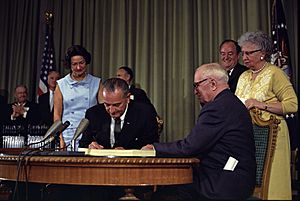Medicare (United States) facts for kids
| Agency overview | |
|---|---|
| Formed | July 30, 1965 |
| Headquarters | 7500 Security Boulevard, Baltimore, MD 21244 |
| Agency executive |
|
| Parent department | Centers for Medicare and Medicaid Services |
Medicare is a special health insurance program in the United States. It helps people pay for their medical care. This program is mainly for people who are 65 years old or older. It also helps younger people with certain long-term health conditions. These conditions include some disabilities, serious kidney disease, and ALS (also known as Lou Gehrig's disease).
Medicare started in 1965. It was first part of the Social Security Administration. Today, the Centers for Medicare and Medicaid Services (CMS) runs the program. In 2022, Medicare helped about 65 million people. Most of these were older adults. About 8 million were younger people with specific health needs.
Medicare usually covers about half of a person's healthcare costs. Many people get extra private insurance to help pay for the rest. They might also join special Medicare health plans. Even with Medicare, people often have other costs. These can include small fees for doctor visits or hospital stays. Medicare does not cover everything, like long-term personal care.
Medicare is divided into four main parts. These are called Part A, Part B, Part C, and Part D. Each part covers different types of medical services.
Contents
Understanding Medicare's Parts
Medicare is split into different sections. Each section helps pay for specific health services.
Part A: Hospital and Hospice Care
Part A helps pay for care when you are admitted to a hospital. This includes inpatient hospital stays. It also covers care in a skilled nursing facility after a hospital stay. Home health care and hospice services are also covered. Hospice care helps people who are very ill.
Part B: Medical Services
Part B covers many outpatient services. This means care you get without staying overnight in a hospital. It includes most doctor visits. It also helps with outpatient hospital charges. Durable medical equipment, like wheelchairs, is covered too. Most prescription drugs given by a doctor or nurse are also part of Part B.
Part C: Medicare Advantage Plans
Part C is another way to get your Medicare benefits. These plans are often called Medicare Advantage plans. They are offered by private insurance companies. These plans must cover everything that Parts A and B cover. Many Part C plans also offer extra benefits. These can include dental, vision, or hearing care. Most Part C plans also include prescription drug coverage (Part D). A key difference is that Part C plans have a yearly limit on how much you pay out of your own pocket.
Part D: Prescription Drugs
Part D helps pay for most prescription drugs that you take yourself. These are medicines you get from a pharmacy. This part helps make prescription drugs more affordable.
Medicare's History
Medicare has a long and interesting history. It was created to help older Americans get the healthcare they needed.
Early Ideas for Healthcare
The name "Medicare" was first used in 1956. It referred to a program for military families. In 1961, leaders started discussing a healthcare program for older people. This idea came from a White House meeting on aging.
Creating the Medicare Program
Many attempts were made to pass a healthcare bill for the elderly. Finally, in 1965, a bill passed Congress. President Lyndon B. Johnson signed it into law on July 30, 1965. This law created Medicare as we know it today. It was part of the Social Security Act of 1965.

The signing ceremony was held at the Harry S. Truman Presidential Library and Museum. Former President Harry S. Truman and his wife, Bess, became the very first people to receive Medicare benefits. Before Medicare, many older adults could not afford health insurance. It was often too expensive for them.
Medicare's Impact on Society
Medicare also played a role in racial integration in the United States. In 1966, Medicare payments were only given to healthcare providers who ended segregation. This helped lead to the desegregation of many hospitals and clinics.
Changes Over Time
Medicare has changed a lot since 1965. In 1972, it started covering more types of therapy. These included speech, physical, and chiropractic therapy. In the 1970s, Medicare also began working with health maintenance organizations (HMOs). Hospice benefits were added in the 1980s.
Later, Medicare expanded to cover younger people with permanent disabilities. This included those with ALS and serious kidney disease. In 1997, President Bill Clinton expanded the HMO option, which became Medicare Part C. In 2003, President George W. Bush signed a law creating Medicare Part D. This part helps cover the cost of prescription drugs.
How Medicare is Paid For
Medicare gets its money from different sources. This money helps pay for the healthcare services it provides.
Payroll Taxes
A big part of Medicare Part A is paid for by payroll taxes. This is a small tax taken from the paychecks of most workers. Employers also pay a part of this tax. Self-employed people pay both parts. This money goes into a special fund to help pay for hospital care.
Other Funding Sources
Medicare also gets money from other places. Some comes from the U.S. government's general funds. People who use Medicare also pay monthly fees, called premiums, for some parts of the program. These different sources help keep Medicare running.
Future Challenges
The number of people using Medicare is growing. This is because the "Baby Boom" generation is getting older. More people using the program means more money is needed. Healthcare costs are also rising across the country. These factors create challenges for Medicare's future funding. Experts are always looking for ways to keep the program strong.
Who Can Get Medicare?
Generally, you can get Medicare if you are 65 or older. You or your spouse must have paid Medicare payroll taxes for a certain number of years. If you haven't paid enough taxes, you might still be able to get Part A. However, you would need to pay a monthly fee for it. Younger people with specific long-term disabilities or illnesses can also qualify.
Images for kids
See also
 In Spanish: Medicare para niños
In Spanish: Medicare para niños





